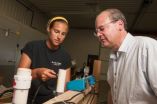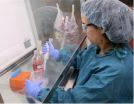(Press-News.org) WASHINGTON, Aug. 15, 2012 — Progress toward developing an alternative to organ transplantations in which doctors could actually grow a new heart or liver for a patient is among the topics in the 2012 premier of a popular video series from the American Chemical Society (ACS), the world's largest scientific society. The videos are available at www.acs.org/PrizedScience and on DVD.
Titled Prized Science: How the Science Behind American Chemical Society Awards Impacts Your Life, the first episode of the 2012 series features the research of Dr. Robert Langer, winner of the 2012 ACS Priestley Medal. He is a professor at the Massachusetts Institute of Technology. The Priestley Medal is the highest honor of the ACS, and it recognizes Langer's pioneering work making body tissues in the lab by growing cells on special pieces of plastic. Langer's team has used the approach to make skin for burn patients, for instance, with the goal of eventually making whole organs for transplantation.
Next in the 2012 launch is an episode of Prized Science featuring Dr. Chad Mirkin, winner of the 2012 ACS Award for Creative Invention. The video explains how Mirkin's research has provided patients with faster diagnoses for influenza and other respiratory infections, and new tests that improve care for heart disease.
Upcoming episodes feature:
Vicki Grassian, Ph.D.: ACS Award for Creative Advances in Environmental Science and Technology
Diane Bunce, Ph.D.: George C. Pimentel Award in Chemical Education
Peter Wolynes, Ph.D.: ACS Award in Theoretical Chemistry
ACS encourages educators, schools, museums, science centers, news organizations and others to embed links to Prized Science on their websites. The videos discuss scientific research in non-technical language for general audiences. New episodes in the series, which focuses on ACS' 2012 national award recipients, will be issued periodically.
The 2012 edition of Prized Science is completely refreshed, with a new look and feel, with renowned scientists telling the story of their own research and its impact and potential impact on everyday life. Colorful graphics and images visually explain the award recipient's research.
The ACS administers more than 60 national awards to honor accomplishments in chemistry and service to chemistry. The nomination process involves submission of forms, with winners selected by a committee consisting of ACS members who typically are technical experts in the nominee's specific field of research.
INFORMATION:The American Chemical Society is a nonprofit organization chartered by the U.S. Congress. With more than 164,000 members, ACS is the world's largest scientific society and a global leader in providing access to chemistry-related research through its multiple databases, peer-reviewed journals and scientific conferences. Its main offices are in Washington, D.C., and Columbus, Ohio.
To automatically receive news releases from the American Chemical Society, contact newsroom@acs.org.
END
VIDEO:
This computer animation, created using new software called Arepo, simulates nine billion years of cosmic history. Arepo can accurately follow the birth and evolution of thousands of galaxies over billions...
Click here for more information.
Scientists at the Harvard-Smithsonian Center for Astrophysics (CfA) and their colleagues at the Heidelberg Institute for Theoretical Studies (HITS) have invented a new computational approach that can accurately follow the birth and ...
EAST LANSING, Mich. — A professor at Michigan State University is part of a team developing a new method of removing phosphorous from our wastewater – a problem seriously affecting lakes and streams across the country.
In addition, Steven Safferman, an associate professor of biosystems and agricultural engineering, and colleagues at Columbus, Ohio, based-MetaMateria Technologies, are devising a cost-effective way of recovering the phosphorous, which then can be reused for fertilizer products.
Although its use is regulated in many states, including Michigan, in items ...
In public comments submitted yesterday, People for the Ethical Treatment of Animals (PETA) applauds the United States Department of Agriculture (USDA) Center for Veterinary Biologics (CVB) for announcing its plans to allow firms to secure exemptions from the target animal batch safety tests (TABST) that have until now been required for each batch of veterinary biologics products, including live and inactivated vaccines. In draft memorandum 453, USDA states that CVB intends to consider TABST exemptions in line with recommendations in the TABST waiver guideline drafted by ...
Amid policy debate over potential liquefied natural gas (LNG) exports from the United States, a new paper from Rice University's Baker Institute for Public Policy predicts the long-term volume of exports from the U.S. will not likely be very large. The paper also argues that the impact on U.S. domestic natural gas prices will not be large if exports are allowed by the U.S government.
Significant changes in the global gas market in the past decade, particularly the emergence of shale in North America, have dramatically altered the global outlook for LNG markets and ...
Amsterdam, NL, August 15, 2012 – In a study published in the current issue of Restorative Neurology and Neuroscience scientists report that a therapy combining exercise with the neurovascular protective agent S-nitrosoglutathione (GSNO) improved recovery from stroke in a rat model. GSNO is a compound found naturally in the body and it has no known side effects or toxicity.
"In our study, GSNO or motor exercise provided neuroprotection, reduced neuronal cell death, maintained tissue structure, and aided functional recovery by stimulating the expression of neuronal repair ...
The World Health Organization estimates that in 2011 there were 216 million cases of malaria and 34.2 million people living with HIV. These diseases particularly afflict sub-Saharan Africa, where large incidence of co-infection result in high mortality rates. Yet, in spite of this global pandemic, interactions between the parasite that causes malaria, Plasmodium falciparum, and HIV-1 are poorly understood. However, a new video article in JoVE, the Journal of Visualized Experiments, that describes a novel technique to study the interactions between HIV-1 and P. falciparum ...
BOSTON--The genomic tumult within tumor cells has provided scientists at Dana-Farber Cancer Institute and the Broad Institute of MIT and Harvard with clues to an entirely new class of genes that may serve as an Achilles' heel for many forms of cancer.
As reported in the Aug. 17 issue of the journal Cell, the researchers identified 56 such genes, only a few of which had previously been identified as potential targets for cancer therapy. Unlike most such targets, these genes don't cause normal cells to turn cancerous. Instead, they are essential to all cells but have been ...
PHILADELPHIA — Treatment with denosumab resulted in a greater reduction in skeletal-related events in patients with breast cancer that spread to the bones compared with zoledronic acid, while also maintaining health-related quality of life, according to the results of a phase III study published in Clinical Cancer Research, a journal of the American Association for Cancer Research.
"Our data indicate that denosumab should be the treatment of choice for the prevention of skeletal-related events and hypercalcemia in patients with breast cancer that has metastasized to the ...
How the intricate network of blood vessels forms within the brain has long fascinated biologists. Though the human brain comprises only 2 percent of body weight it receives up to 15 percent of the cardiac output through this network, or vessel vasculature. The vasculature in the human brain consists of a complex branching network of blood vessels, in total some several hundred miles in length. The network is formed so as to distribute blood efficiently to all brain regions, and abnormalities can lead to various neurological disorders, including strokes, learning difficulties ...
Among pregnant women who did not develop gestational diabetes, overweight women were 65 percent more likely, and obese women 163 percent more likely, to have overly large babies than their healthy weight counterparts. In this study, an overly large infant was identified based on having a birth weight over the 90th percentile for their gestational age at delivery and gender. Gaining excess weight during pregnancy also contributed to having a large for gestational age baby, regardless of maternal weight or whether she developed gestational diabetes.
This Kaiser Permanente ...



